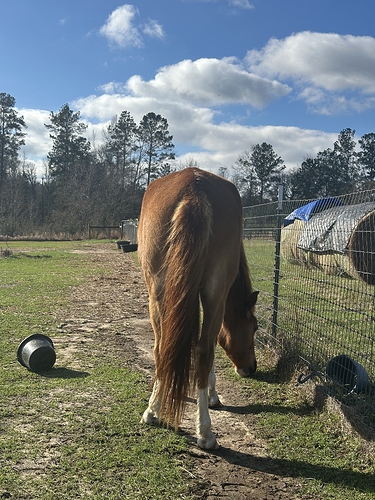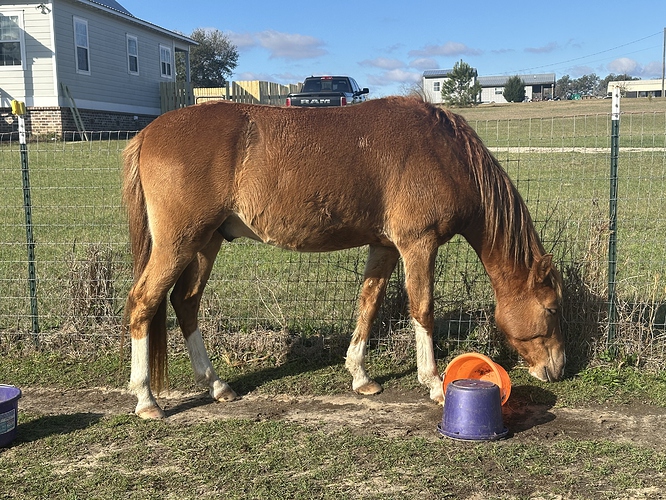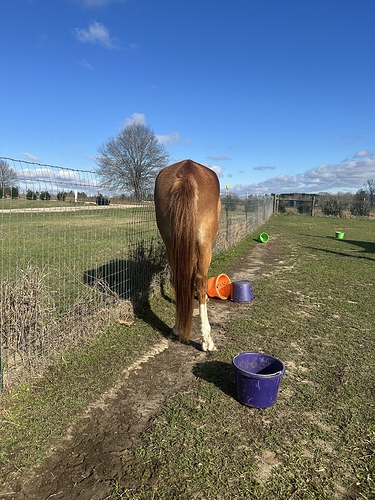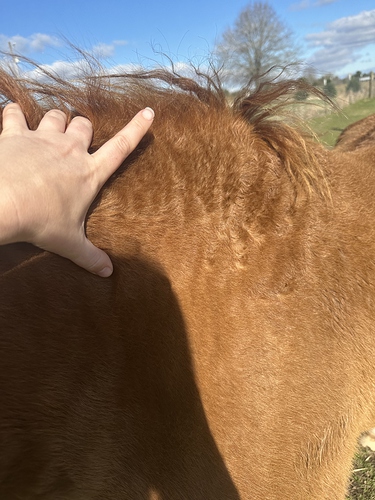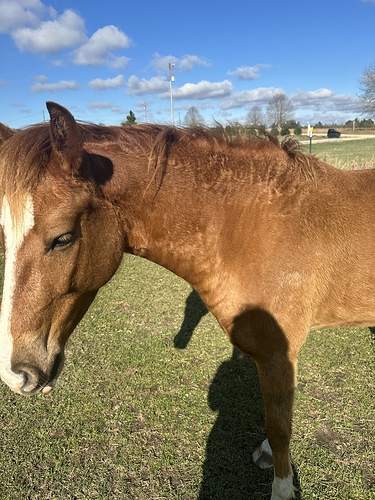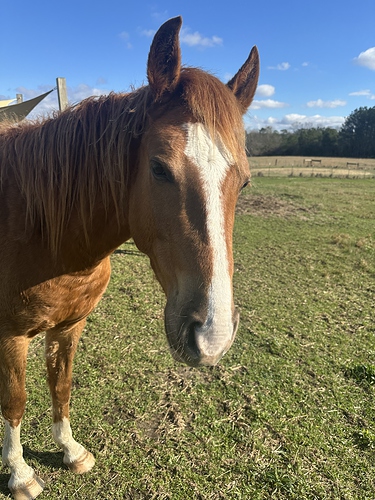Does this happen? I’m not sure if I should up my boys food or not. His hip and top of his bum has points but I realized his neck feels really fatty. He looks like he could use more food to me, but the neck is making me second guess that. He’s a 14.1 paso fino and gets unlimited grass hay plus 2 quarts of a 12% feed(triumph) and 1 quart of the top line empower 30% feed. I was giving him 3 quarts of 12 % but dropped it down again when I realized how chubby his neck was. We’re not very active right now, usually just riding once a week.
I’m no expert but if a healthy horse is on 24/7 access to forage then he likely doesn’t need much else to eat except a ration balancer.
This is just a general statement. Horses do vary.
But I have recently been there. Pronounced cresty neck, then within a month fat deposits started in the rear end, followed very quickly by laminitis. I learned a hard and expensive lesson about over-feeding.
Actually, I was just going to suggest OP contact his/her veterinarian and ask about testing for insulin resistance. I would check the diet for total NSC as much as possible. Laminitis would be a fear for me, as well.
I second the ration balancer. We have multiple heavier built breeds at the barn I work at, they all get an appropriate amount of Tribute Essential K plus their 24/7 hay buffet in slow feed nets. They do tend look a little weird during the winter here, they’ll lose weight in some places but maintain a serious fat pad in others. They’re all kept in full work and look way better during the summer.
Considering yours is idle / light work according to the feed guidelines, its probably too much feed.
Check the amount of NSC you are feeding. It is dietary starch + sugar. Easy keepers should generally have low NSC (I think less than 12% is the guideline ?). And weigh your scoop! A quart of one feed will weigh different than a quart of another.
Picture?
Without one it’s not possible to judge conformation vs metabolic issues vs a weight issue
I looked up the NSC of Nutrina Triumph 12% feed. If this is the one you are feeding, if it were my horse, I would stop immediately. The starch is 16% and the sugar is 6% totaling 22% in that feed alone.
That seems worrisome to me. I believe Paso Fino’s fall into the group of breeds predisposed to laminitis. Hopefully, @JB, @Montana’s Girl, or someone more knowledgeable than I will chime in. And, I’d get that insulin tested ASAP.
Yes, Pasos are among those more prediposed to EMS than the general population
Ok, that’s a lot to think about. And I am worried about laminitis due to him being pony sized, I guess I was thinking I needed to increase his protein and a few months ago the vet had mentioned he thought he was a bit thin. I’m used to seeing more fleshed out round hind ends as examples of good weight but maybe he’s just not designed that way. I’ll try to get a pic tomorrow. Could it be lack of muscle that might be causing him to have a pointy appearance?
I found for my EMS horse, who also happens to have a soy allergy, that soy protein made him more prone to develop concerning fat deposits even when his overall condition was not bad. Dunno if that’s some sort of metabolic sensitivity to the soy or related to the allergy exactly. But might be worth trying a soy free feed as well as checking insulin.
The ration balancer purina enrich plus and alfalfa pellets have been a great way to get protein into my horses. My coming 5yo mare really began to blossom when I started her on the enrich plus as a 3yo!
I went ahead and ordered some of the essential k, I’m going to probably start switching it out and see how they like it.
I don’t necessarily have an EMS horse but my PRE is an easier keeper and the breed in general tends to be that way. I switched from a ration balancer with soy to one without soy, and I saw a big difference after a few weeks. He lost the fat concerning deposits and is finally at a weight I feel more comfortable with going into spring (if/when it ever arrives!).
I really didn’t think changing the balancer would do much, but it’s the only thing that’s changed.
So for a metabolic type, I’d consider soy free. It’s an easy enough change to make IMO, but I know that availability of feeds can be a factor.
Unlimited grass hay and 3 quarts of feed on a 14.1 Paso that is newly hippy would definitely make me want to run a metabolic panel.
Sorry, to avoid misunderstanding, the pointiness isn’t new but the thicker neck is. I didn’t really think there was anything wrong with how he looked until the vet mentioned it and decided to try upping his food. He is just about to turn 4 so I don’t know how that plays into it too. Edit: I’ve had him since he was 2.5.
It’s very difficult to judge body condition in photos - accurate BCS evaluation requires hands-on palpation. However, from what I can see, this horse looks like one that could use more calories, not less. The feed he’s currently on isn’t particularly high NSC at 22% (assuming the number reported upthread is accurate), but it’s also not particularly high quality.
If he were mine, I’d move him to a higher quality concentrate fed per label directions for his age and level of work. What kind of forage is he on, and how much (in pounds) does he eat? Increasing the forage quality and/or quantity is often a more cost-effective method for improving weight and topline. With the right forage, he probably could move to a ration balancer, since most Pasos are fairly easy keepers.
He’s very cute! A bit thin with a cresty neck could be cushings. It’s almost time for spring shots. I’d have the vet out a bit early and discuss a metabolic panel including cushings.
In the book “Alone With Your Horse” Mary Jean Vasiloff, a Morgan breeder, gave a very good tip about fatty necks.
Feel the crest of your horse’s neck around halfway down the crest. If the neck feels as hard as a rock IMMEDIATELY put your horse in the weight loss paddock (little or no grass) and cut down the grain drastically or just don’t feed grain until the horse loses some weight (good grass hay is fine). Since most of my horses were small, very food efficient horses, I checked their necks every day. One day a veterinarian got after me because my horses looked thinner than a lot of the horses he’d seen, I just told him that my horses were super feed efficient and I did not want to deal with laminitis. None of the other vets saw anything wrong.
I want to be able to see faint outlines of the last four ribs under the fat. Further forward I want to be able to feel the ribs if I press down on the fatty layer. If I cannot feel a rib anywhere on the horse’s barrel I consider the horse WAY too fat. I loath seeing horses who are too fat, all I can think is that the horse is in danger of laminitis.
He’s on free choice Bahia hay and lives out 24/7 on a paddock with basically just nibbling grass. The triumph was what he was on when he got to me, and it’s just a cheaper feed. It’s also kind of hard to find the nsc, they don’t put the starch or sugar on the guaranteed analysis and it’s milled regionally. I only saw that number on another forum so I’m not sure where that number came from either. The top line empower only has 14% nsc so I guess I could just switch him to that until the essential k comes in. I might just use the triumph as a garnish until it’s all gone.
It’s pretty wobbly, so not rock hard, I do check my donkey’s necks pretty regularly, it just surprised me because his mane kind of covers his neck. I was fiddling with him and realized it had gotten chonkier. Maybe the vet is more used to quarter horse types and he looks thin in comparison.

